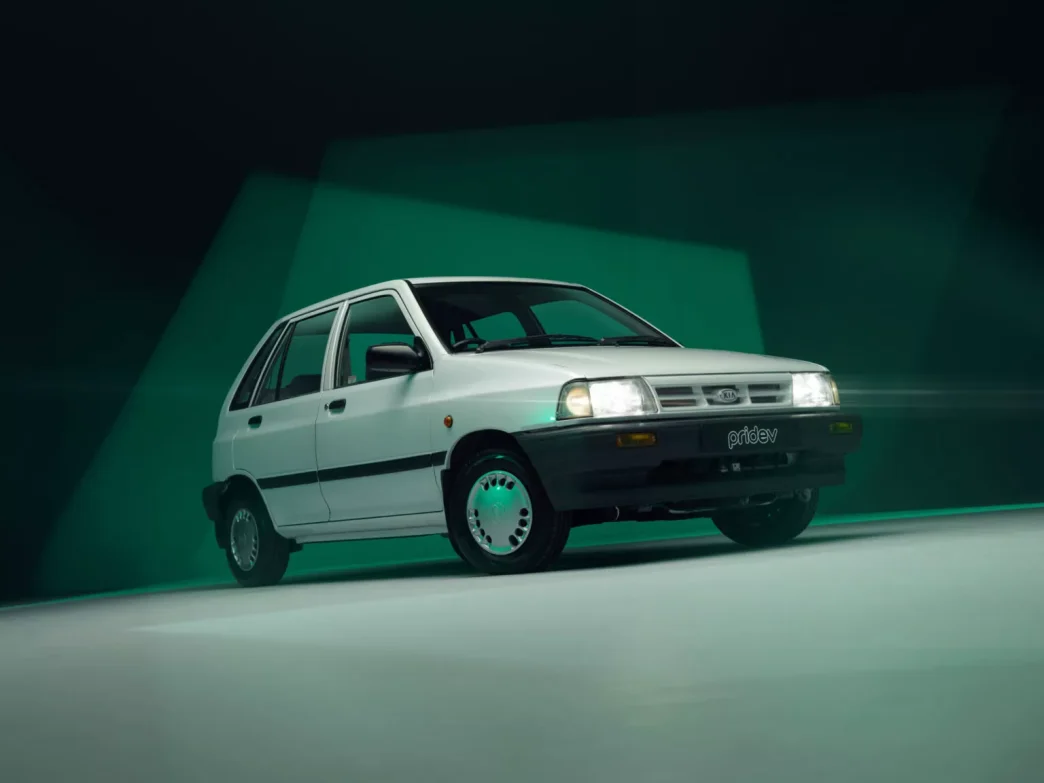Kia has taken a bold and surprising step into the world of restomods by transforming a 1996 Kia Pride into an all-electric vehicle, complete with a five-speed manual transmission. This one-of-a-kind build, created in collaboration with Electrogenic, is Kia UK’s tribute to the company’s 80th anniversary, blending nostalgia with modern electric performance in a way that few could have anticipated.
Originally known as the Ford Festiva in many markets, the Kia Pride was a humble economy car based on a Mazda platform. Kia’s history traces back to 1944, when it began as a manufacturer of bicycle parts, producing Korea’s first domestically-built bike in 1951.

Over the decades, Kia evolved, building motorcycles and eventually vehicles under license from Mazda. The 1986 Pride was one of the first models produced through Kia’s joint venture with Ford, marking an important step in the automaker’s history. Sold as the Ford Festiva in North America, the Mazda 121 in Europe, and the Kia Pride in its home market, the model’s legacy has endured in markets like Iran, where it continues to be built under license today.
For this special project, Kia UK chose a 1996 five-door hatchback version of the Pride and turned it over to Electrogenic, a specialist in converting classic vehicles to electric power. Gone is the original 1.3-liter four-cylinder engine, which produced just 60 horsepower and 87 lb-ft of torque.

In its place, Electrogenic installed an electric motor that produces 107 horsepower and 173 lb-ft of torque, more than doubling the original output. For driving versatility, the motor is programmed with three modes: a Sport mode that unleashes full power, an Eco mode that mimics the original engine’s modest performance, and an Auto mode that strikes a balance between the two.
Powering this restomod are two 10 kWh battery packs, one located under the hood and the other beneath the trunk floor, giving the Pride EV a range of around 120 miles on a single charge. Despite the new electric powertrain, the vehicle’s weight has only increased by 44 pounds, bringing the total to 1,910 lbs. The minimal weight gain allows the car to retain much of its original handling dynamics.

One of the most distinctive aspects of the Pride EV is its cabin, which remains nearly identical to the stock 1996 version. The analog gauge cluster has been retained, with the original gas gauge now displaying the battery charge level. Remarkably, Kia and Electrogenic kept the five-speed manual transmission, pairing it with the electric motor via a high-performance clutch kit. This means the driver still shifts through the gears manually, adding a unique tactile experience that is rare in electric vehicles.
The exterior also remains largely unchanged, with only subtle nods to the EV conversion, such as the green accents on the upholstery, which mirror the color scheme found on Kia’s modern electric performance models. The charging port is cleverly hidden behind the original fuel filler door, which still operates with a classic key-lock mechanism.

Despite its transformation, the Pride EV retains the essence of the original car. Kia and Electrogenic were careful to make the conversion fully reversible. None of the original components were permanently altered, allowing the car to be converted back to its gasoline-powered form if desired.
Though Kia has yet to release official performance numbers for the electric Pride, it’s safe to assume that it will far outpace the original version, which took 11.8 seconds to reach 62 mph. This blend of classic design, modern electric power, and manual transmission makes the Kia Pride EV one of the most intriguing restomods on the market today, offering a nostalgic yet forward-thinking celebration of the brand’s 80-year journey from bicycles to electric cars.













